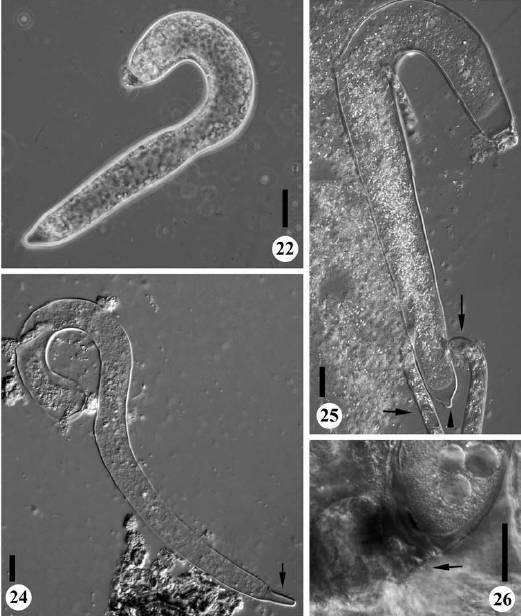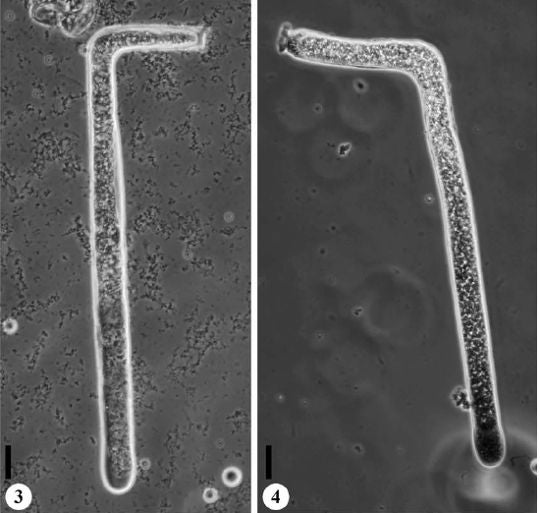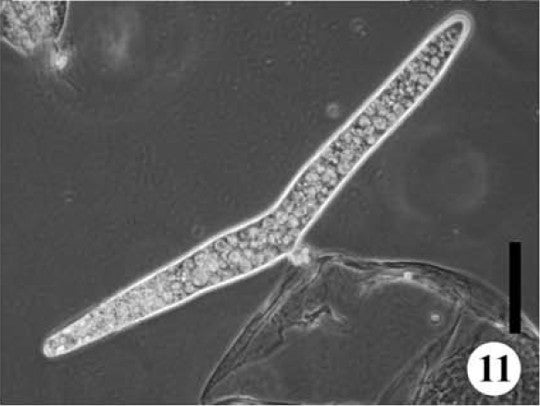This article was published in Scientific American’s former blog network and reflects the views of the author, not necessarily those of Scientific American

Candy cane? Shepherd's staff? Paramoebidium ecdyonuridaei. Scale bar = 25 micrometers. Credit: Valle 2014
Author’s note: This is the latest post in the
Wonderful Things series. You can read more about this series here.
On supporting science journalism
If you're enjoying this article, consider supporting our award-winning journalism by subscribing. By purchasing a subscription you are helping to ensure the future of impactful stories about the discoveries and ideas shaping our world today.
In the backside of certain mayfly nymphs in the streams of Spain and France lives an amoeba shaped like a candy cane. Why, you may ask, does it choose such a domicile and appearance? To the first, I can say: everyone loves a free lunch. And to the second: I really have no idea.
Calling it an amoeba may be a slight stretch, however. It's only an amoeba for a short part of its life. Amoeba – non-italicized – is a description rather than a classification. Amoebas are basically amorphous single-celled eukaryotes, organisms containing a nucleus and a passel of other fancy cellular furniture (all living creatures except bacteria and archaea are eukaryotes).
The largest group of amoebas, the
Amoebozoa, are the ones everyone thinks of when they think of an amoeba, like the one pictured at the top of this blog. But there are many other groups of microbes that produce amoebas at various stages of their lives. One such is Paramoebidium, a group of around 17 known species of microbes called protists.
These organisms make spores that seek larval or nymphal aquatic insects, usually flies, stoneflies, or mayflies. Once in contact with the aforementioned host, the spores germinate to form a small single-celled sac-like or filamentous body that is variously straight, branched, bent, or curved into crowbars, antlers, boomerangs, or candy canes (and in at least one case, a whopping 2 millimeters long).

Crow bar? Egyptian hieroglyph? P. angulatum. Scale bar = 25 micrometers. Credit: Valle 2014
This oddly-shaped organism glues itself to the back end of the insect’s digestive tract. At that point, Paramoebidium feasts upon whatever leftovers happen to come its way. No known benefit is provided to the insect (although that may well be from lack of looking, not lack of providing), but neither does any harm seem to be done.
Of course, welding yourself to the hinder of an aquatic insect presents a rather crucial existential problem: every so often that insect is going to shed its exoskeleton, which unfortunately includes both the surface you are living upon and, of course, you. The hindgut, the politely named terminal section of an insect’s reproductive tract, is continuous with the exoskeleton, so when the shell goes, it all goes. You can’t just unglue yourself. What do you do?
To negotiate this obstacle, Paramoebidium has evolved to sense when shedding is imminent or the insect has been injured. The warning triggers the generation and release of teardrop-shaped amoebas from the mother ship attached to the hind gut. Unleashed on the world, and being good amoebae, these cells do in fact crawl or swim a little way in search of shelter, often conveniently located inside the nearby newly shed exoskeleton of the insect. Eventually, though, the amoebas encyst. Inside these cysts spores are formed and later released. When the spores encounter the proper host in the proper place, they germinate to start the whole cycle over again.

Four-point rack? P. avitruviense. Scale bar = 25 micrometers. Credit: Valle 2014

Immature P. avitruviense bears an uncanny resemblance to a boomerang. Credit: Valle 2014
Crowbar-shaped creatures that live inside the nymphs of aquatic insects seems about as obscure as you can get -- until you consider the total number of aquatic insects on Earth and the resulting potential real estate. Suddenly they don’t seem so unimportant. The backside of aquatic insects is indeed a widespread and hip hangout, given that two other groups of protists --
Amoebidium and the Eccrinales -- and two groups of fungi, the Harpellales and Asellariales, have all evolved to live in the same place, doing more or less the same thing. In fact, Paramoebidium was originally mistaken for such fungi, given its filamentous habit and spore-making abilities.
Why does Paramoebidium adopt such peculiar shapes? Obviously more surface area yields more available space for absorbing food, but why a cane? Why a crowbar? Why antlers? Why haven’t they all converged on a single ideal shape? What would a mayfly nymph think of having its backside crammed with protists shaped like household objects? Does it make you as happy as it does me to live on a planet where all this is the case?
Reference
Valle, Laia Guàrdia. "
New species of Paramoebidium (trichomycetes, Mesomycetozoea) from the Mediterranean, with comments about the amoeboid cells in Amoebidiales." Mycologia 106, no. 3 (2014): 481-490.